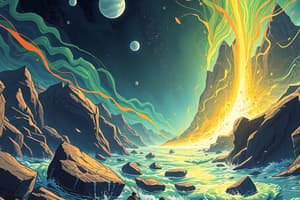Podcast
Questions and Answers
Which of the following statements best describes the relationship between energy and matter?
Which of the following statements best describes the relationship between energy and matter?
- Matter acts upon energy to cause change.
- Energy acts upon matter to cause change, but is not itself matter. (correct)
- Energy and matter are interchangeable and have the same properties.
- Energy is a form of matter that can be created and destroyed.
A student observes a light bulb converting electrical energy into light and heat. Which law describes this process?
A student observes a light bulb converting electrical energy into light and heat. Which law describes this process?
- The Law of Universal Gravitation
- The Law of Conservation of Mass
- The Law of Thermodynamics
- The Law of Conservation of Energy (correct)
In a system, the energy input is 100J. If the useful energy output is 30J, what is the waste energy?
In a system, the energy input is 100J. If the useful energy output is 30J, what is the waste energy?
- 70J (correct)
- 130J
- 100J
- 30J
Which of the following best describes the purpose of a Sankey diagram?
Which of the following best describes the purpose of a Sankey diagram?
Which modification to a machine would most likely increase its energy efficiency?
Which modification to a machine would most likely increase its energy efficiency?
What is the fundamental principle behind how electrical generators produce electricity?
What is the fundamental principle behind how electrical generators produce electricity?
Why is coal considered a non-renewable energy source?
Why is coal considered a non-renewable energy source?
What distinguishes a renewable energy source from a non-renewable one?
What distinguishes a renewable energy source from a non-renewable one?
How does the flow of electrons create electricity?
How does the flow of electrons create electricity?
Why are ammeters placed in series circuits?
Why are ammeters placed in series circuits?
Flashcards
What is energy?
What is energy?
What makes things happen. It is not matter, but acts upon it.
Kinetic Energy
Kinetic Energy
Energy that an object has due to its motion.
Potential Energy
Potential Energy
Energy that is stored in an object or system.
Law of Conservation of Energy
Law of Conservation of Energy
Signup and view all the flashcards
Energy Efficiency
Energy Efficiency
Signup and view all the flashcards
Sankey Diagrams
Sankey Diagrams
Signup and view all the flashcards
Conductors
Conductors
Signup and view all the flashcards
Insulators
Insulators
Signup and view all the flashcards
Voltage
Voltage
Signup and view all the flashcards
Current
Current
Signup and view all the flashcards
Study Notes
- Energy makes things happen.
- Energy is not matter, but acts upon matter.
- Energy compels matter to perform actions.
Types of Energy
- Energy is classified into kinetic and potential forms.
- Kinetic: Mechanical, Sound, Electrical, Thermal, Light.
- Potential: Chemical, Nuclear, Gravitational, Elastic.
Law of Conservation of Energy
- Energy cannot be created or destroyed.
- Energy can be converted from one form to another.
- Energy can be transferred from one object to another.
- The total energy in the universe is constant.
- Transformation of energy involves changing energy from one form to another.
- Transfer of energy involves moving energy from one place to another, possibly without transformation.
Energy Efficiency
- Useful energy is the energy that is needed.
- Waste energy is the energy that is not needed.
- Energy efficiency occurs when an object's input is predominantly high in useful energy rather than waste energy.
- Energy efficiency is calculated as (Useful energy output / Total energy output) x 100%.
Sankey Diagrams
- Sankey Diagrams represent energy transformations.
- They visually convey the amount of inputted energy and the amount of output energy converted into different types.
- A higher proportion of useful energy output indicates energy efficiency.
- A higher proportion of useless energy output indicates waste energy.
- The thickness of arrows represents the amount of energy involved.
Increasing Energy Efficiency
- Streamlined shapes, lubrication, and thermal insulators increase energy efficiency.
Sources of Energy
- Electrical generators must spin a metal coil around a magnet to start the flow of electrons through the metal – creating electricity.
- All electricity production using a generator requires an input of some form of energy to make the coil spin.
Coal
- Coal is a significant source of electricity in Australia.
- Coal is made of ancient plant remnants compacted over millions of years.
- Coal is a near-pure form of carbon.
- Coal contains chemical energy between chemical bonds.
- Chemical bonds are flammable/combustible.
- Burning coal heats water to produce steam.
- High-pressure steam forces a turbine to spin a coil in a generator, starting the movement of electrons in wires, and creating electricity.
- Burning of coal generates carbon dioxide which is released to the atmosphere.
Renewability and Sustainability
- Renewability is the term to describe how quickly resources form.
- Non-renewable resources: Form over very long periods and have a fixed amount like coal, oil, natural gas, nuclear energy.
- Renewable resources: Regenerate quickly and have an infinite supply like solar, hydro-electrical, geothermal, tidal, wind, biomass.
- Sustainability depends on the ability to continue indefinitely, where resources are not used up faster than generated.
Electricity
- Matter is made up of atoms.
- Electrons possess a negative charge and can move between atoms.
- The movement of electrons creates an imbalance of charge-static electricity/stationary electricity.
- Protons possess a positive charge.
- Like-charged objects repel while opposite charges attract.
- Electricity is a constant flow of electrons from one atom to the next.
Conductors vs. Insulators
- Conductors have loosely bound electrons that can be passed between atoms, allowing electricity to flow.
- Insulators have tightly bound electrons that cannot be passed between atoms, not allowing electricity to flow.
Circuits
- Consist of:
- A power source
- A conductor connecting all the components
- A device which uses the electrical charge
- A switch to connect or break the circuit (optional)
Voltage
- Voltage represents the difference in potential energy between two points in a circuit.
- Voltage describes how much energy each charge contains.
- Voltage is the attraction or push of electrons across the circuit.
- Potential is measured in volts (V) with a voltmeter.
- Voltage is measure of the (potential) difference in energy between the electrons entering and leaving the circuit at the power source.
- The difference in energy between electrons is the attraction or the push of electrons across the circuit.
- Voltage is the cause of a current.
- A voltmeter is always placed in a parallel circuit to measure the 'push' across the light bulb.
- Voltage does not remain consistent throughout the circuit.
Current
- Current measures how fast charge moves in a circuit (how many electrons are flowing through the circuit per second).
- Current is the effect of voltage.
- Current is measured in amps (A).
- Currents can move in either direction through the position of charge.
- Ammeters are always placed in series circuits to measure the flow within the circuit.
Studying That Suits You
Use AI to generate personalized quizzes and flashcards to suit your learning preferences.




